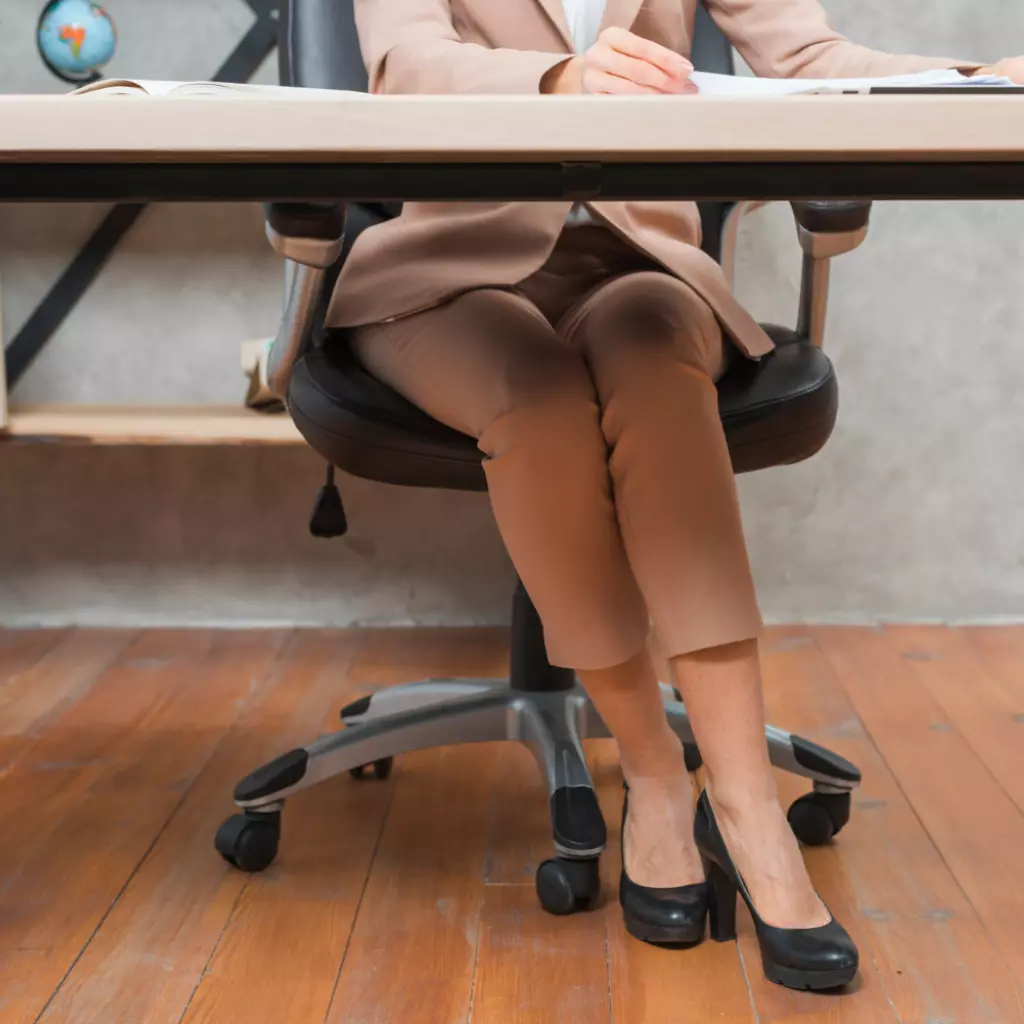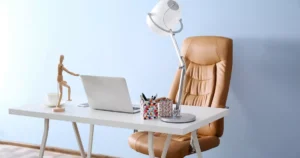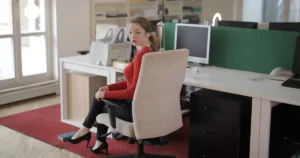Have you ever been sitting in your office chair and accidentally rolled away from your desk at the wrong moment? If you’ve experienced the frustration of an uncontrollable rolling office chair, you’ve come to the right place. In this article, we’ll discuss various simple and effective methods you can use to stop your office chair from rolling when you don’t want it to. Whether it’s locking casters, applying rubber pads or using a stopper mat, by the end of this guide you’ll know how to stop office chair from rolling and keep your chair in place so you can focus on getting work done without distractions.
Why Does My Office Chair Keep Rolling?
Understanding why chairs roll to begin with can help shed light on solutions. Most office chairs are designed with wheeled casters underneath to allow for smooth mobility around the workspace. While rolling chairs provide flexibility of movement, the casters can make the chair too mobile at times when stability is needed most. Here are a few common reasons why an office chair may be rolling excessively:
- Loose or worn casters: Over time and with heavy use, the wheels and axles that connect the casters to the chair can become loose, worn, or damaged. Loose casters will cause the chair to roll too freely without control.
- Smooth floor surface: Chairs roll smoothly over smooth, flat flooring like hardwood, laminate, tile, or polished concrete. Carpet, area rugs, and textured flooring provide more traction to slow rolling.
- Chair weight limit exceeded: Heavy loads over the intended weight capacity can overload and imbalance the caster mechanisms, leading to uncontrolled rolling.
- Improper chair height: Chair casters are engineered to balance and roll smoothly at a certain recommended height range. If the chair is too high or low, rolling will be affected.
- Leaning/shifting body weight: Any weight shifts or leaning while seated transfers momentum to the wheels, triggering rolling motions.
Solutions for Stopping Office Chair Rolling
With an understanding of typical causes, let’s explore some practical solutions for stopping excessive office chair rolling.
Locking Casters
One of the most common and straightforward ways to control the movement of an office chair is through its wheels, also known as casters. Most office chairs have five wheels – four swivel casters that allow the chair to smoothly roll in any direction and one chair mechanism caster that remains stationary. Many of these casters are designed to lock in place to prevent rolling. To lock the casters:
- Tip your chair backward so you have access to the wheels.
- Locate the wheel lock levers, which are usually metal tabs integrated into the plastic caster housing.
- Simply flip each caster lock lever down to lock that caster in place. This prevents it from rolling.
- Repeat for all four swivel casters until your chair is fully locked.
To unlock the casters and allow rolling again, simply flip the levers back up. Regularly locking and unlocking your casters gives you full control over your chair’s mobility. Just be sure not to leave any casters permanently locked, as this could damage the wheels over time.

Caster Replacements
If the locking mechanism on your chair’s casters no longer works well or the casters themselves are worn, a caster replacement may solve rolling issues. Many office supply stores sell replacement casters compatible with popular office chair models.
When selecting new casters, consider options like:
- Rigid (non-swiveling) casters: Rigid casters don’t spin, keeping the chair firmly planted. Ideal for carpeted areas.
- Dual-wheel casters: Two small wheels provide more surface contact for enhanced stability and reduced rolling.
- Locking casters: Choose replacement casters with durable built-in locking tabs or levers.
- Larger caster diameters: Larger 5″ casters roll over bumps better but provide less mobility than standard 2″-3″ casters.
- Materials: Durably constructed plastic or metal casters will last longer than cheap plastic versions.
Removing old casters requires some basic hand tools. De-mount and mount new casters by following the instructions included. Proper caster replacements can eliminate rolling issues for years.
Rubber Chair Pads/Glides
While caster locks are convenient for fine-tuning your chair’s movement, another popular option is applying rubber pads or chair glides to the bottom of your chair’s legs. Rubber stops rolling more effectively than locked wheels alone. There are a few rubber pad styles to choose from:
- Self-adhesive felt pads – Peel and stick pads that adhere to chair legs. Provide a soft grip.
- Screw-on plastic glides – Glides with threaded holes to screw onto chair legs for a secure grip.
- Snap-on glide caps – Plastic caps that snap over chair legs. Durable design.

No matter the style, rubber pads/glides accomplish two things: They provide traction between your chair and floor, preventing sliding. They also elevate the chair slightly for better floor protection and rolling mobility when needed. Simply apply pads to one or more chair legs for a no-slip solution. Rubber works well on most floor types.
Stopper Mats
If you want to define an exact “no-roll zone” at your desk, consider using a special stopper mat. These rubber mats have a high-traction top surface designed specifically for office chairs. Simply place the mat where you need your chair to stop rolling, such as:
- Directly under your desk workspace
- In front of your computer tower
- By your door to prevent chair roll-aways

When the wheels of your chair contact the textured stopper mat surface, traction is created to hold the chair firmly in place. No adjustments are required – the mat does the stopping work automatically. Get a shape and size that perfectly fits your space. Stopper mats seamlessly integrate protection and control into your setup.
Alternative Flooring and Surfaces
If chair adjustments, locks and stops are not completely solving rolling issues, consider swapping out the flooring underneath and around the chair. Hard, slick surfaces like laminate, tile or hardwood tend to allow chairs to roll freely even with precautions. Carpet or thick area rugs give wheels more friction to resist movement on the other hand.

You can lay a non-slip rug, mat or furniture slider specifically under the chair footprint as a DIY remedy. Or simply rearrange your workspace to another rug if possible. For desk areas, anti-fatigue floor mats, interlocking foam tiles or executive floor mats provide a stickier floor surface than bare flooring.
If space permits, you may also think about whether it would work better to position the chair where it rolls against a stationary object like a desk, cabinet or wall. The contact point creates natural resistance similar to chair stops. Adjusting the layout and floor surfaces – even in small ways – could make rolling that much harder versus easier based on the conditions. Don’t overlook environmental adjustments too.
Adjusting Your Seated Position
In addition to looking at the chair itself, consider whether slight adjustments to how you sit could help limit rolling motions. For example, positioning your weight more towards the front half of the chair seat rather than leaning all the way back can dramatically decrease how easy it is for the chair to roll backward or forward.

Sitting up straight with your back flush against the backrest also shifts your center of gravity forward in a balanced manner. This makes it harder for light, accidental pushes from your limbs to disturb the chair’s rolled position. On the flip side, avoid slouching deeply into the chair or leaning too far to one side when working, as these postures compromise stability.
Maintaining proper lumbar support as well as core and hip alignment also contributes to being grounded and balanced in the chair, thus reducing how likely it is to respond to small nudges and nudges and roll uncontrollably. While not a direct ‘solution’, optimizing your seated ergonomics can certainly help diminish rolling tendencies.
Other Rolling Control Methods
A few other rolling control techniques you may find useful:
- Use an anti-roll dowel or wooden block – Place a simple wooden dowel between the front chair legs for a budget-friendly stopper.
- Apply bicycle inner tube pieces – Cut strips from an old inner tube and attach them under chair legs for extra grip where needed.
- Place area rugs strategically – Choose low-pile rugs that provide grip beneath your chair wheels in key locations.
- Adjust chair wheel type/size – Replacing standard casters with smaller, softer wheels can reduce rolling.
- Clear floor obstacles – Remove any cables, boxes or other tripping hazards your chair could roll into.
Common Mistakes While Trying to Stop Rolling
Here are some common mistakes people make when trying to stop their office chair from rolling:
- Over-tightening the adjustment mechanisms on the chair. This can damage parts over time. Go gradually with the tightening.
- Only apply wheel locks or stops to some wheels, not all. The chair may still be able to roll on the unlocked wheels. Lock all wheels/casters.
- Not positioning wheel locks or stops close enough to the perimeter of the chair base. This leaves gaps for rolling. Put them as close to the edge as possible.
- Relying only on chair adjustments without additional locks/stops. Adjustments alone may not provide enough friction on some surfaces.
- Using homemade stops that are too thin/light. Thick, heavyweight materials work best as stops. Light items can be easily rolled over.
- Placing stops in uneven patterns instead of surrounding the chair. Gaps allow rolling to still occur.
- Skipping regular checks of locks/stops and readjusting over time. Friction wears down effectiveness. Periodic tightening is needed.
- Assuming rolled resistance means rolling is fully stopped. Some side-to-side or swivel motion may still occur.
- Not addressing the floor surface. Rolls better on carpet vs slick tile. Rugs and mats can help provide resistance.
- Ignoring ergonomic position factors that aid rolling. Good posture keeps you stable and the chair in place better.
The key is using multiple sturdy solutions, surrounding the full perimeter of the chair base for complete rolling control. Regular checks also keep methods working long-term.
Final Thoughts
Whether you opt for caster locks, rubber pads, stopper mats or another rolling control solution, there are simple steps you can take to prevent unwanted chair movement and keep your workstation ergonomics in order. With a bit of adjustment or adding the right accessories, you’ll have full mastery over your chair’s mobility, allowing you to stay focused on work and productivity. Implement one or more rolling control techniques discussed, and your office chair will no longer roll away from you when you least expect it. I hope this guide has provided effective rolling solutions to help you improve your workspace and bring more control to chair rolling.
Frequently Asked Questions (FAQs)
Here are some frequently asked questions about stopping an office chair from rolling, along with answers:
Q: Why does my office chair keep rolling even after I adjusted it?
The adjustments may not have been tight enough, or you need additional wheel locks or chair stops to fully prevent rolling.
Q: What’s the easiest way to stop rolling?
Using wheel locks that clamp onto each wheel is often the simplest and quickest solution. Just tighten them down.
Q: Is there a cheap way to do it?
You can improvise by wrapping elastic bands or strips of cloth tightly around each wheel as a homemade solution.
Q: Can I use things around the house?
Yes, thick books, pieces of wood or cardboard can work as mini chair stops under the legs. Rolled-up towels also make barriers.
Q: Will it damage the chair long-term?
No, as long as you don’t over-tighten parts. Light adjustments, locks and stops won’t cause any issues over time.
Q: Why does my chair still roll a little?
Minor rolling is normal with locks – you want resistance, not a frozen chair. Positioning yourself properly also affects stability.
Q: Will it still roll on the carpet?
Carpet provides more grip than hard floors, but locks and stops can further ensure no rolling on any surface.







